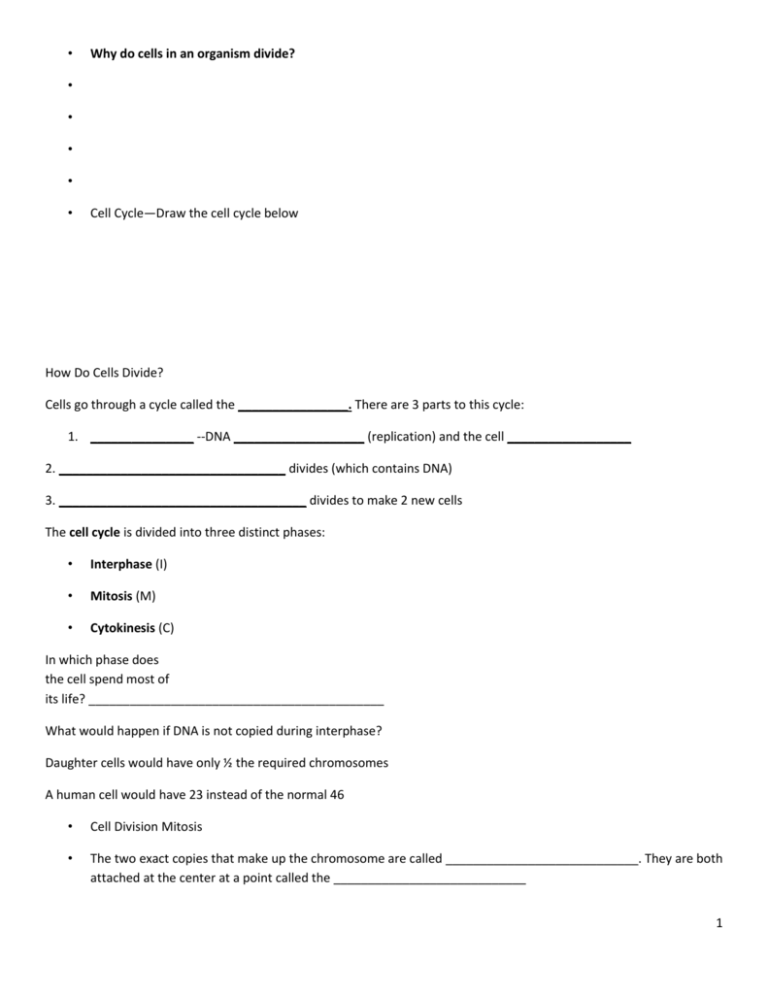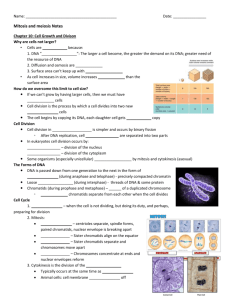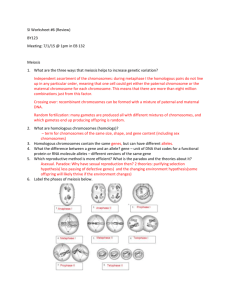Guided notes for mitosis and meiosis 2-6-15
advertisement

• Why do cells in an organism divide? • • • • • Cell Cycle—Draw the cell cycle below How Do Cells Divide? Cells go through a cycle called the ________________. There are 3 parts to this cycle: 1. _______________ --DNA ___________________ (replication) and the cell __________________ 2. _________________________________ divides (which contains DNA) 3. ____________________________________ divides to make 2 new cells The cell cycle is divided into three distinct phases: • Interphase (I) • Mitosis (M) • Cytokinesis (C) In which phase does the cell spend most of its life? ___________________________________________ What would happen if DNA is not copied during interphase? Daughter cells would have only ½ the required chromosomes A human cell would have 23 instead of the normal 46 • Cell Division Mitosis • The two exact copies that make up the chromosome are called ____________________________. They are both attached at the center at a point called the ____________________________ 1 • Each of the 23 pairs consists of two _____________________________________________ • Homologous chromosomes are similar in size, shape and genetic content. One is from the mother, and one from the father. • All of the cells in the body other than gametes are considered ______________________________, in that they contain two sets of DNA, they are said to be ______________________ • In the case of gametes the cells are __________________________, containing only half the DNA. • 22 of those chromosomes are referred to as ___________________________ • The last pair of chromosomes is called a sex chromosome because they determine the sex of the individual • • XX- female XY- male Cells with special functions, such as the nerve cell or cheek cell might look different but each one has 46 chromosomes in the human • • • After Mitosis each daughter cell must have 46 chromosomes or 23 pairs • • Replication-process of making exact copies of the DNA strand o Stages of Cell Division 1. _________________________- the cell grows and copies DNA 2. _______________________-(cell division) • Stage 1:prophase-spindle _____________________ form • Stage 2:metaphase-sister chromatids line up in the _________________ of the cell • Stage 3:Anaphase-chromosomes move to opposite ______________________of the cell • Stage 4:Telophase-the cell begins to ___________________ in half 3. ______________________________- the cytoplasm is split in half to form ____________________ o Key Players in the Mitotic Phase 1. Nucleus – Control center that holds _____________________ 2. DNA – Can exist in several forms 1. Chromatin – refers to all the DNA in a cell. DNA is called chromatin when it is _________ coiled. 2 2. Chromosomes – Rod shaped structure that forms when DNA is _____________ coiled. Humans have _________ Chromosomes 3. C. Sister chromatids. When DNA has copied itself, there are __________ of each chromosome. The copies attach to each other and form sister chromatids. • Sister chromatids are attached in the _____________________ at a region called the centromere. • Centrioles – 2 ___________ _____________ proteins that help move chromosomes (Only found in eukaryotes). *Centrosomes are regions that help organize the spindle fibers • Spindle Fibers – a set of _________________ that form between the centrioles to help the chromosomes move. *Made of microtubules o • Meiosis Why is it important? • You could not have been created without it! • • Cell division to produce gametes (egg and sperm) • These cells are haploid (N)= They contain only half the chromosomes of somatic (body) cells. • One chromosome from each homologous pair. • Humans contain 22 pairs of autosomes and two sex chromosomes. • The sex chromosomes determine the gender of an individual. • • Females can only contribute an X to their egg. • Males can contribute either an X or a Y to the sperm. • Therefore, males determine the sex of a baby. • Meiosis occurs only in the reproductive tissue – Ovaries and testes Has same 4 phases of mitosis ( prophase, metaphase, anaphase, telophase) Meiosis creates variety in the genes of living organisms Independent assortment:One chromosome from each homologous pair is randomly given to each gamete 3 • The way is which the homologous pair lines up is random Meiosis in males is different than in females o Draw the chart Female Meiosis OOGENESIS • The fetus develops primary oocytes which have 46 chromosomes (diploid). • DNA is replicated and meiosis stops in prophase. Restarts at puberty. • At puberty females have about 400,000 primary oocytes. • Each month one primary oocyte completes meiosis I • • Secondary oocyte starts meiosis II but stops at metaphase. Then ovulation occurs. • If fertilization occurs then meiosis II continues. Meiosis II results in one haploid 23 chromosome egg (OVA) and a polar body. • Fertilization occurs when the egg and sperm fuse to form a diploid zygote. • o MALE Meiosis Spermatogenesis • Spermatogonia develop in the fetus and rest until puberty. • At puberty these cells develop into primary spermatocytes (diploid). • After mieosis I two secondary spermatocytes are produced. • Meiosis II results in two spermatids which are haploid, n=23. • Spermatids undergo spermiogenesis to become mature sperm. • The whole process from primary spermatocyte to sperm takes about 74 days. Sperm can live in the female reproductive tract for about 48 hours. • • • The volume of semen in a single ejaculation may vary from 1.5 to 6.0 ml. There are usually between 50 to 150 million sperm per milliliter of semen. 4 o Meiosis – Making sex cells • REMEMBER: humans have 23 PAIRS of chromosomes. Both chromosomes in a pair carry similar information. These are called ____________________________________. (Homo = same) • Each sex cell needs to have ___________________________ in order to function correctly. Homologous chromosomes have different versions of the same genes. A version of a gene is called an ____________. • One cell divides into ________ cells, each with __________ the number of chromosomes as the original cell. • REMEMBER: Humans have 23 pairs of chromosomes. Both chromosomes in a pair carry similar information. These are homologous chromosomes. Each sex cell needs to have one chromosome from each pair in order to function correctly. ***How would the effect of a mutation in a body cell be different than the effect of a mutation in a gamete? 5









